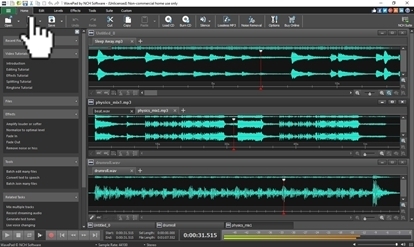You cannot record your voice directly over the music file using WavePad, but you can create a separate voice file and then mix the files together using the Paste Mix feature. Use WavePad to record the voice file Open the music file and the voice file in WavePad Select and copy the voice track.
Wavepad is a great tool to make good recordings of sermons, this video will show you the basic use of it. WavePad is a sound editor program for Windows. WavePad lets you make and edit voice and other audio recordings. Removal. Recorder supports autotrim. 24 or 32 bits. Pre. In seperate screens. Allows. IT Major Elective3 Project Like & Share.
MP3MyMP3 is a rather simple sound recorder which can capture the playback of several different sources of audio including streams, music players and microphone.
Another feature which is included with MP3MyMP3 is its ability to rip tracks from audio CDs. Additionally, MP3MyMP3 can also scan your system for sound files and play them back.
The application has a user-friendly user interface with a black theme by default which may be changed by the user.
Mp3MyMP3 is software which can record audio.
Installation note: During the installation process of Mp3MyMP3, you may be prompted to change your browser homepage and search engine settings or install additional offers. Vt miltope laptops & desktops driver download for windows 10. Spartek usb devices driver.
Features and highlights
- Record PC audio output
- Record audio tracks from CDs
- Schedule recordings by time and date
- Batch file rename feature
- Includes playlist
Mp3MyMP3 4.2.3 on 32-bit and 64-bit PCs
This download is licensed as freeware for the Windows (32-bit and 64-bit) operating system on a laptop or desktop PC from sound/audio recorders without restrictions. Mp3 My MP3 Recorder 4.2.3 is available to all software users as a free download for Windows.
Filed under:- Mp3MyMP3 Download
- Freeware Sound/Audio Recorders
- Major release: Mp3MyMP3 4.2
You want easy? I got easy.
I’ve written a simple tutorial showing how to record audio using my favorite free audio editor, WavePad (no affiliate links here, btw).You may have heard of Audacity, the well-known, open-source sound editor. Most people who create audio online use it and recommend it, but I’ve found it to be less than user-friendly. For one thing, you have to download and install a special file that allows you to convert your original .WAV recording to MP3, the format most used for listening to online audio. For a non-techie, that’s a barrier right there. After that, learning how to use Audacity is daunting for beginners.
That’s why I rave about WavePad, and urge you to try it instead. There’s no special file to install – MP3 conversion is built-in. You can choose from one of the pro versions that cost upwards of fifty bucks, but you don’t need all those bells and whistles to record your podcasts and interviews. The free version will do just fine. And it’s much easier to learn than Audacity.
So let’s give it a spin, shall we?
Recording Audio with WavePad
Wavepad Sound Recorder
- First, download and install the free version of WavePad, then start the program. This is what it will look like (sort of – I have the Advanced version):
Click to enlarge
- Click “New File”in the upper left corner. Click OK to the box that pops up (no need for stereo.) Now you have an empty file, ready for recording:
- Click the red Record button in the lower left corner. A Record Control window will pop up:
Click to enlarge
- A. Leave this as Untitled.
- B. Check to make sure the Device listed is the microphone you are using.
- C. Make sure the Input has Master Volume selected.
- D. Adjust the volume with the Volume Control bar, if necessary.
- Make sure your microphone is on, click the Record button inside the Record Control window, and say a few words.
Notice the Recording Volume bar moving as you speak. Don’t worry if it peaks in the red zone, but keep it mostly in the green. (You can adjust this with the Volume Control bar (D):
- Click the square Stop button to see the visual depiction of your voice waves. Pretty cool, huh?
Click to enlarge
Note: See what I did here? It’s too loud. The Volume bar is all the way in the red, and some of my voice waves are jammed flat against the top and bottom of the window. It’s okay if a few of them hit the top and bottom, but not this many. If it’s too loud, your voice will sound distorted and icky.
Here’s what your voice waves should look like (note that the Volume bar is set to 0DB (zero decibels):
Don’t worry if the sound waves are smaller than you see here, even after you’ve set the volume as loud as it will go. I’ll show you how to adjust that in the next tutorial.
- Stop recording and close the Record Control window. Your recorded file will transfer to the Editing window – it’s magic!
- Save File As and give the file a name. Click OK.
- Now, Save File As again and Save As Type – choose .mp3. Click OK.
Et voila – done!
That wasn’t so bad, was it? Download landtec north america driver.
But if you just want someone to do it for you, I’m your woman!
Sign up here and I’ll get in touch.
Wavepad Sound Recorder
Coming up in the next few posts, I’ll show you how to normalize the volume, record interviews on Skype, edit your sound files – and even add music.

Wavepad Sound Recorder Download
See you soon!
